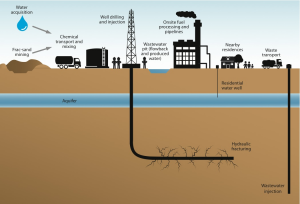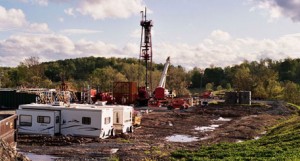Methane in Texas water wells ‘likely natural’ – UTA study
Researchers studied 784 freshwater wells for methane leakage in Barnett, Haynesville, Eagle Ford, Delaware Basin shale plays
By Seth Whitehead, Energy In Depth
Researchers from the University of Texas at Austin have released a report that further contributes to the overwhelming body of evidence that the hydraulic fracturing process has not contaminated drinking water in Parker County – or anywhere else in Texas, for that matter.
 The study’s authors concluded:
The study’s authors concluded:
“All elements of the study point to natural methane contamination in the Parker-Hood cluster.”
This conclusion reaffirms the findings of the Railroad Commission of Texas, which showed – through nitrogen fingerprinting – that the water contamination was naturally occurring and not from fracking, proving that EPA’s unprecedented endangerment order against Range Resources was baseless.
The researchers reached similar conclusions throughout the entire study area, finding the presence of high dissolved methane concentrations from 784 freshwater wells in the Barnett, Haynesville, Eagle Ford and Delaware Basin shale plays “are likely natural” and not related to fracking. From the report:
“Overall the source of the dissolved methane is likely natural sourced from shallow natural gas accumulations in the Barnett Shale, lignite beds associated with a fault in the Haynesville shale, and lignite and degradation of oil and deep organic matter associated with a fractured zone in the Eagle Ford Shale. The Delaware Basin samples show no dissolved methane other than associated to a recent blowout.” (pg. iii)
 Though some high concentrations of thermogenic methane associated with oil and gas production were found in the study regions, the authors emphasized that there are a number of natural pathways that explain the presence of such methane in aquifers:
Though some high concentrations of thermogenic methane associated with oil and gas production were found in the study regions, the authors emphasized that there are a number of natural pathways that explain the presence of such methane in aquifers:
“… there is no need to invoke gas leakage to explain field observations. Structural and stratigraphic features explain the presence of thermogenic methane in shallow groundwater in the Haynesville and Barnett shale plays.” (pg. 80)
In no instance did the report find a shred of evidence linking methane contamination to hydraulic fracturing process, and the researchers believe that although potential oil and gas related sources of contamination such as well integrity failure cannot be ruled out, they are not likely common:
“Undoubtedly accidents happen and some of the high-methane in water wells we sampled could actually be the result of recent contamination. In the light of the results of the study, we believe these wells are in small number if they exist.” (pg. 1)
The fact that instances of high methane concentrations were often in clusters that did notcorrelate with high concentrations of gas wells further illustrates why the researchers believe high methane concentrations in groundwater are likely natural.
Here is a look at what the researchers found in each major Texas shale play:
Barnett/Parker County
 Parker County become a focal point of anti-fracking activists’ efforts to convince the public that fracking contaminates drinking water several years ago due in large part to the distribution of a deceptive video in which a local resident is shown allegedly lighting his water on fire. However, numerous investigations by the RCC proved the methane was naturally occurring from the shallow Strawn formation, not the Barnett. A court subsequently ruled the case was based on a “deceptive video” in which the resident deliberately hooked up the hose to a gas vent.
Parker County become a focal point of anti-fracking activists’ efforts to convince the public that fracking contaminates drinking water several years ago due in large part to the distribution of a deceptive video in which a local resident is shown allegedly lighting his water on fire. However, numerous investigations by the RCC proved the methane was naturally occurring from the shallow Strawn formation, not the Barnett. A court subsequently ruled the case was based on a “deceptive video” in which the resident deliberately hooked up the hose to a gas vent.
The UT study reaffirmed the RCC’s findings, as the researchers believe thermogenic methane contamination in the Parker County cluster is the result of water wells being drilled into gas-bearing zones, most often the Strawn formation, and not the Barnett. This a logical conclusion, considering the Strawn lies just below the aquifer, and approximately 5,300 feet of geological strata separate the aquifer from the Barnett Shale.
The researchers also noted that the dissolved methane in these instances is in low enough concentrations that entire aquifers are not affected. Other experts have proven that the methane found in these wells does not have the same nitrogen content of Barnett Shale gas, and the UT-Austin researchers agree.
“Our field observations in the Barnett Shale suggest there are two types of water wells with methane: (1) wells directly tapping a small non-economic accumulation (of gas) of the Center Mill type at the top of the Lower Strawn … and (2) wells tapping the Trinity or the Strawn with dissolved methane either at saturation or not at sampling depth.” (pg. 80)
“Although some samples with low methane concentrations are clearly microbial, all high dissolved methane samples are thermogenic, genetically related to shallow reservoirs in the Strawn Formation of Paleozoic age and seem to be mostly natural.” (pg. vi)
The researchers also found that areas of high methane concentrations did not match to areas with high well density, further illustrating why they believe that the methane contamination is unrelated to oil and gas activity. Anti-fracking activists have attempted to link groundwater methane concentration to fracking by looking for contamination close to wells, but no such relationship exists in the Barnett:
“In the Marcellus Shale, some authors have postulated that methane concentration is a function of proximity to gas wells (Osborn et al., 2011; Jackson et al., 2013) or of topography (Molofsky et al., 2013). Neither relationships holds in the Barnett … Plots displaying methane vs. distance to Barnett and non-Barnett wells in Parker, Hood and Somervell counties show that the highest methane concentrations are not necessarily close to gas wells, either Barnett or non-Barnett, and that there is no monotonic increasing function of methane as the sampling point approaches a gas well.” (emphasis added; pg. 68)
Researchers also tested for chemicals believed to be associated with oil and natural gas development. Of the samples taken from water wells in the area, no such compounds were found.
“We also analyzed 25 water samples in the Parker-Hood cluster for BTEX (LCRA lab, Austin, TX), all individual BTEX components were non-detect.” (p. 69)
Overall, the Parker County cluster is the only area of the Barnett and the 450 wells sampled there that the researchers encountered any significant issues, finding “the vast majority of wells show no to very little methane…”
The researchers’ takeaway on the Parker County case is yet another blow to anti-fracking activists who have pinned hopes of justifying revision to EPA’s groundwater report that found “hydraulic fracturing activities have not led to widespread, systemic impacts to drinking water resources,” to the Parker County cluster.
Haynesville
Of 70 samples taken in the Haynesville region, a cluster next to the Panola-Shelby County line were the only wells to show significant methane.
The researchers believe that the thermogenic methane present in this cluster originated from the Wilcox lignite rather than the Haynesville Shale and traveled to aquifers through the Mount Enterprise Faults. The latter conclusion was based on samples with the highest thermogenic methane concentrations being near these faults.
“The dissolved methane spatial distribution suggests a strong association with the Mount Enterprise Fault system. Plotting of methane concentration vs. distance confirms quantitatively the association with the highest concentrations closest to the fault zone (distances were calculated as the shortest distance between sampling point and any of the individual fault of the system)…” (pg. 47)
Eagle Ford
Similar to the Haynesville, the researchers believe instances of high thermogenic methane concentrations from its 118 samples in the Eagle Ford are at least partially attributable to the Wilcox lignite.
Interestingly, none of their samples from this region showed a clear thermogenic signature, even at depth, leading the researchers to come to the conclusion that the methane in the area is, “mostly biogenic methane showing some biodegradation characteristics and possibly originating from the degradation of oil leaking from deeper deposits through vertical features (faults or fractures) combined with some thermogenic methane originating from the lignite beds.”
The post originally appeared on the Energy In Depth website on Feb. 11, 2016. Energy In Depth is a research, education and public outreach campaign funded by the Independent Petroleum Association of America.







Alternate explanation for the good wet/dry ratio — each hole inevlvos a mess of horizontal drilling, and if the first stabs don’t indicate gas where expected, then the rest of the drilling might not follow.Or, alternate #2, first you drill down, and that down-hole drilling is not “dry” unless all horizontal runs from it are dry (we do more than one, right?)